Morphodiversity as a Tool in Geoconservation: A Case Study in a Mountain Area (Pieniny Mts, Poland)
Abstract
1. Introduction
2. Materials and Methods
2.1. Geological and Geomorphological Setting
2.2. Nature Conservation
2.3. Statistical Zones
2.4. Outline of the Assessment Methodology
2.5. Relief Features Discretisation
2.6. Evaluation Criteria
2.7. Data Acquisition and Preparation
2.8. Morphodiversity Models Preparation
2.9. Partial Diversity Criteria Analysis
2.10. Clustering of Morphodiversity Assessments
2.11. Searching for Hot and Low Spots
3. Results
3.1. Morphodiversity Evaluation
3.2. Autocorrelation of Morphodiversity
3.3. Verification of Existing Protected Area Boundaries
4. Discussion
5. Conclusions
Author Contributions
Funding
Institutional Review Board Statement
Informed Consent Statement
Data Availability Statement
Conflicts of Interest
References
- Semeniuk, V. The Linkage between Biodiversity and Geodiversity. In Pattern & Processes: Towards a Regional Approach to National Estate Assessment of Geodiversity; Eberhard, R., Ed.; Australian Heritage Commission & Environment Forest Taskforce, Environment: Canberra, Australia, 1997; Volume 2, pp. 51–58. [Google Scholar]
- Gaston, K.J. Global Patterns in Biodiversity. Nature 2000, 405, 220–227. [Google Scholar] [CrossRef]
- Jedicke, E. Biodiversität, Geodiversität, Ökodiversität. Kriterien Zur Analyse Der Landschaftsstruktur—Ein Konzeptioneller Diskussionsbeitrag. Naturschutz Und Landschaftsplanung 2001, 33, 59–68. [Google Scholar]
- Antonelli, A.; Kissling, W.D.; Flantua, S.G.A.; Bermúdez, M.A.; Mulch, A.; Muellner-Riehl, A.N.; Kreft, H.; Linder, H.P.; Badgley, C.; Fjeldså, J.; et al. Geological and Climatic Influences on Mountain Biodiversity. Nat. Geosci. 2018, 11, 718–725. [Google Scholar] [CrossRef]
- Alahuhta, J.; Toivanen, M.; Hjort, J. Geodiversity—Biodiversity Relationship Needs More Empirical Evidence. Nat. Ecol. Evol. 2019, 4, 2–3. [Google Scholar] [CrossRef] [PubMed]
- Stanley, M. Geodiversity. Earth Herit. 2000, 14, 15–18. [Google Scholar]
- Stanley, M. Geodiversity: Our Foundation. Geol. Today 2003, 19, 104–107. [Google Scholar] [CrossRef]
- Gray, M. Geodiversity: The Origin and Evolution of a Paradigm. Geol. Soc. Lond. Spec. Publ. 2008, 300, 31–36. [Google Scholar] [CrossRef]
- Gray, M. Geodiversity: Valuing and Conserving Abiotic Nature, 2nd ed.; Wiley-Blackwell: Chichester, UK, 2013. [Google Scholar]
- Brilha, J.; Gray, M.; Pereira, D.I.; Pereira, P. Geodiversity: An Integrative Review as a Contribution to the Sustainable Management of the Whole of Nature. Environ. Sci. Policy 2018, 86, 19–28. [Google Scholar] [CrossRef]
- Hjort, J.; Gordon, J.E.; Gray, M.; Hunter, M.L. Why Geodiversity Matters in Valuing Nature’s Stage. Conserv. Biol. 2015, 29, 630–639. [Google Scholar] [CrossRef]
- Bravo-Cuevas, V.M.; González-Rodríguez, K.A.; Cabral-Perdomo, M.A.; Cuevas-Cardona, C.; Pulido-Silva, M.T. Geodiversidad y Sus Implicaciones En La Conservación de La Biodiversidad: Algunos Estudios de Caso En El Centro de México. CIENCIA Ergo-Sum 2021, 28, 1–15. [Google Scholar] [CrossRef]
- Gray, M. Geodiversity and the Ecosystem Approach. Parks Steward. Forum 2022, 38, 39–45. [Google Scholar] [CrossRef]
- Tukiainen, H.; Toivanen, M.; Maliniemi, T. Geodiversity and Biodiversity. Geol. Soc. Lond. Spec. Publ. 2023, 530, 31–47. [Google Scholar] [CrossRef]
- Cleal, C.J.; Thomas, B.A.; Bevins, R.E.; Wimbledon, W.A.P. GEOSITES—An International Geoconservation Initiative. Geol. Today 1999, 15, 64–68. [Google Scholar] [CrossRef]
- Osborne, R.A.L. Presidential Address for 1999–2000. Geodiversity: “Green” Geology in Action. Proc. Linn. Soc. New South Wales 2000, 122, 149–173. [Google Scholar]
- Kot, R. Georóżnorodność—Problem Jej Oceny i Zastosowania w Ochronie i Kształtowaniu Środowiska Na Przykładzie Fordońskiego Odcinka Doliny Dolnej Wisły i Jej Otoczenia; Towarzystwo Naukowe w Toruniu, Uniwersytet Mikołaja Kopernika: Toruń, Poland, 2006. [Google Scholar]
- Comer, P.J.; Pressey, R.L.; Hunter, M.L.; Schloss, C.A.; Buttrick, S.C.; Heller, N.E.; Tirpak, J.M.; Faith, D.P.; Cross, M.S.; Shaffer, M.L. Incorporating Geodiversity into Conservation Decisions. Conserv. Biol. 2015, 29, 692–701. [Google Scholar] [CrossRef]
- Crofts, R. Linking Geoconservation with Biodiversity Conservation in Protected Areas. Int. J. Geoheritage Parks 2019, 7, 211–217. [Google Scholar] [CrossRef]
- Bartuś, T. Struktura i Różnorodność Abiotycznych Komponentów Krajobrazu w Ocenie i Delimitacji Obszarów Chronionych Na Przykładzie Ojcowskiego Parku Narodowego i Jego Otoczenia; Wydawnictwa AGH: Kraków, Poland, 2020. [Google Scholar]
- Crofts, R.; Gordon, J.E.; Brilha, J.; Gray, M.; Gunn, J.; Larwood, J.; Santucci, V.; Tormey, D.; Worboys, G.L. Guidelines for Geoconservation in Protected and Conserved Areas; Groves, C., Ed.; IUCN, International Union for Conservation of Nature: Gland, Switzerland, 2020. [Google Scholar] [CrossRef]
- Fox, N.; Graham, L.J.; Eigenbrod, F.; Bullock, J.M.; Parks, K.E. Incorporating Geodiversity in Ecosystem Service Decisions. Ecosyst. People 2020, 16, 151–159. [Google Scholar] [CrossRef]
- Gordon, J.E.; Bailey, J.J.; Larwood, J.G. Conserving Nature’s Stage Provides a Foundation for Safeguarding Both Geodiversity and Biodiversity in Protected and Conserved Areas. Parks Steward. Forum 2022, 38, 46–55. [Google Scholar] [CrossRef]
- Sharples, C. A Methodology for the Identification of Significant Landforms and Geological Sites for Geoconservation Purposes; Forestry Commission Tasmania: Hobart, Tasmania, Australia, 1993. [Google Scholar]
- Sharples, C. Practical Implementation of Geoconservation. In Concepts and Principles of Geoconservation; Park and Wildlife Service, Department of Environment and Land Management: Tasmania, Australia, 2002. [Google Scholar]
- O’Halloran, D.; Green, C.; Harley, M.; Stanley, M.; Knill, J. (Eds.) Geological and Landscape Conservation. In Proceedings of the Malvern International Conference 1993; Geological Society: London, UK, 1994; pp. 1–530. [Google Scholar]
- Brocx, M.; Semeniuk, V. Geoheritage and Geoconservation—History, Definition, Scope and Scale. J. R. Soc. West Aust. 2007, 90, 53–87. [Google Scholar]
- Wimbledon, W.A.P. Geoheritage in Europe and Its Conservation. Episodes 2013, 36, 68. [Google Scholar] [CrossRef]
- Reynard, E.; Brilha, J. Geoheritage: Assessment, Protection, and Management; Elsevier: Amsterdam, The Netherlands, 2018. [Google Scholar]
- Gordon, J.E. Geoconservation Principles and Protected Area Management. Int. J. Geoheritage Parks 2019, 7, 199–210. [Google Scholar] [CrossRef]
- Pescatore, E.; Bentivenga, M.; Giano, S.I. Geoheritage and Geoconservation: Some Remarks and Considerations. Sustainability 2023, 15, 5823. [Google Scholar] [CrossRef]
- Kistowski, M. Regionalny Model Zrównoważonego Rozwoju i Ochrony żrodowiska Polski a Strategie Rozwoju Województw; Uniwersytet Gdański, Bogucki Wydawnictwo Naukowe: Gdańsk, Poznań, Poland, 2003. [Google Scholar]
- IDRME. International Declaration of the Rights of the Memory of the Earth, 13th June 1991; IDRME: Digne, France, 1991; Available online: http://www.progeo.ngo/downloads/DIGNE_DECLARATION.pdf (accessed on 15 June 2023).
- Council of Europe. Pan-European Biological and Landscape Diversity Strategy. Extract of the Declaration Adopted by the Ministers of the Environment in Sofia on 23–25 October 1995. In Nature and Environment; Council of Europe Press: Strasbourg, France, 1996; pp. 1–69. Available online: https://www.cbd.int/doc/nbsap/rbsap/peblds-rbsap.pdf (accessed on 15 June 2023).
- Council of Europe. Recommendation on the Integrated Conservation of Cultural Landscape Areas as Part of Landscape Policies. In Recommendation; Council of Europe Press: Strasbourg, France, 1995; pp. 1–8. Available online: https://wcd.coe.int/ViewDoc.jsp?id=537517 (accessed on 15 June 2023).
- Chmielewski, P. Koncepcje Konserwatorskie w Historii Ochrony Przyrody w Polsce Do 1939 Roku. Zesz. Nauk. Inżynieria Lądowa I Wodna W Kształtowaniu Sr. 2011, 4, 21–25. [Google Scholar]
- Dziedzic, J. Pojmowanie i Organizacja Ochrony Przyrody w Polsce w XIX i Na Początku XX Wieku. Humanistyka I Przyrodozn. 2018, 3, 161–176. [Google Scholar]
- Szymalski, W. (Ed.) 100 Lat Ochrony Środowiska w Polsce; Instytutu Naukowo-Wydawniczego ”Spatium”: Radom, Poland, 2020. [Google Scholar]
- Gągol, J.; Wróblewski, T. Inspekcja Geologiczna Jako Realizacja Monitoringu Litosfery. Przegląd Geol. 1994, 42, 443–445. [Google Scholar]
- Kozłowski, S. Program Ochrony Litosfery Na Lata Dziewięćdziesiąte. Przegląd Geol. 1992, 40, 1–7. [Google Scholar]
- Kozłowski, S. Ochrona Geosfery. Przegląd Geol. 2000, 48, 815–816. [Google Scholar]
- Kozłowski, S. The Proposition of Geosphere Monitoring. Reg. Monit. Nat. Environ. 2003, 4, 23–28. [Google Scholar]
- Kozłowski, S. Postępy Prac Nad Georóżnorodnością w Polsce. Kosmos 2001, 50, 151–165. [Google Scholar]
- Kozłowski, S. Ekorozwój. Wyzwanie XXI Wieku; Wydawnictwo Naukowe PWN: Warszawa, Poland, 2002. [Google Scholar]
- Kozłowski, S. Program Ochrony Georóżnorodności w Polsce. Przegląd Geol. 1997, 45, 489–496. [Google Scholar]
- Kozłowski, S. Geodiversity. The Concept and Scope of Geodiversity. Przegląd Geol. 2004, 52, 833–837. [Google Scholar]
- Kozłowski, S.; Migaszewski, Z.M.; Gałuszka, A. Znaczenie Georóżnorodności w Holistycznej Wizji Przyrody. Przegląd Geol. 2004, 52, 291–294. [Google Scholar]
- Kozłowski, S.; Migaszewski, Z.M.; Gałuszka, A. Gediversity Conservation—Conserving Our Geological Heritage. Pol. Geol. Inst. Spec. Pap. 2004, 13, 13–20. [Google Scholar]
- Resolution Adopted by the General Assembly on 25 September 2015; United Nations: New York, NY, USA, 2015; Available online: https://www.un.org/en/development/desa/population/migration/generalassembly/docs/globalcompact/A_RES_70_1_E.pdf (accessed on 12 July 2023).
- Realizacja Celów Zrównoważonego Rozwoju w Polsce—Raport 2018; Rada Ministrów RP: Warszawa, Poland, 2018.
- Zwoliński, Z.; Najwer, A.; Giardino, M. Methods for Assessing Geodiversity. In Geoheritage: Assessment, Protection, and Management; Reynard, E., Brilha, J., Eds.; Elsevier: Amsterdam, The Netherlands, 2018; pp. 27–52. [Google Scholar] [CrossRef]
- Kiernan, K. Conserving Geodiversity & Geoheritage: The Conservation of Glacial Landforms; Forest Practices Board: Hobart, Australia, 1996. [Google Scholar]
- Dixon, G. Geoconservation: An International Review and Strategy for Tasmania; Parks and Wildlife Service, Occasional Paper: Tasmania, Australia, 1996; Volume 35. [Google Scholar]
- Eberhard, R.; Australian Heritage Commission; Environment Australia. Pattern & Process: Towards a Regional Approach for National Estate Assessment of Geodiversity: Report of a Workshop Held at the Australian Heritage Commission on 26 July 1996/Australian Heritage Commission; Eberhard, R., Australian Heritage Commission, Environment Australia, Eds.; Technical Series; Environment Australia: Canberra, Australia, 1997. [Google Scholar]
- Necheş, I.-M. Geodiversity beyond Material Evidence: A Geosite Type Based Interpretation of Geological Heritage. Proc. Geol. Assoc. 2016, 127, 78–89. [Google Scholar] [CrossRef]
- Räsänen, A.; Kuitunen, M.; Hjort, J.; Vaso, A.; Kuitunen, T.; Lensu, A. The Role of Landscape, Topography, and Geodiversity in Explaining Vascular Plant Species Richness in a Fragmented Landscape. Boreal Environ. Res. 2016, 21, 53–70. [Google Scholar]
- Tukiainen, H.; Bailey, J.J.; Field, R.; Kangas, K.; Hjort, J. Combining Geodiversity with Climate and Topography to Account for Threatened Species Richness. Conserv. Biol. 2017, 31, 364–375. [Google Scholar] [CrossRef]
- Kot, R.; Leśniak, K. Impact of Different Roughness Coefficients Applied to Relief Diversity Evaluation: Chełmno Lakeland (Polish Lowland). Geogr. Ann. Ser. A Phys. Geogr. 2017, 99, 102–114. [Google Scholar] [CrossRef]
- Gonçalves, J.; Mansur, K.; Santos, D.; Henriques, R.; Pereira, P. A Discussion on the Quantification and Classification of Geodiversity Indices Based on GIS Methodological Tests. Geoheritage 2020, 12, 38. [Google Scholar] [CrossRef]
- Chrobak, A.; Novotný, J.; Struś, P. Geodiversity Assessment as a First Step in Designating Areas of Geotourism Potential. Case Study: Western Carpathians. Front. Earth Sci. 2021, 9, 752669. [Google Scholar] [CrossRef]
- Nieto, L.M.; Fernández, T.; Leiva-Lozano, J.E. Assessment of Geodiversity at the Confluence of Different Geological Domains and Delimitation of Natural Protected Areas (Examples from Southern Spain). Geoheritage 2023, 15, 92. [Google Scholar] [CrossRef]
- Malczewski, J. On the Use of Weighted Linear Combination Method in GIS: Common and Best Practice Approaches. Trans. GIS 2000, 4, 5–22. [Google Scholar] [CrossRef]
- Jankowski, P.; Najwer, A.; Zwoliński, Z.; Niesterowicz, J. Geodiversity Assessment with Crowdsourced Data and Spatial Multicriteria Analysis. ISPRS Int. J. Geoinf. 2020, 9, 716. [Google Scholar] [CrossRef]
- Ferrando, A.; Faccini, F.; Paliaga, G.; Coratza, P. A Quantitative GIS and AHP Based Analysis for Geodiversity Assessment and Mapping. Sustainability 2021, 13, 10376. [Google Scholar] [CrossRef]
- Zwolinski, Z.; Najwer, A.; Jankowski, P. Globalnie i Lokalnie Ważona Kombinacja Liniowa Jako Podejście Metodyczne Do Oceny Georóżnorodności Geoparków. Landf. Anal. 2021, 40, 57–69. [Google Scholar]
- Najwer, A.; Jankowski, P.; Niesterowicz, J.; Zwoliński, Z. Geodiversity Assessment with Global and Local Spatial Multicriteria Analysis. Int. J. Appl. Earth Obs. Geoinf. 2022, 107, 102665. [Google Scholar] [CrossRef]
- Mastej, W.; Bartuś, T. Supervised Classification of Morphodiversity Using Artificial Neural Networks on the Example of the Pieniny Mts (Poland). 2023; in press. [Google Scholar]
- Florinsky, I. Digital Terrain Analysis in Soil Science and Geology, 2nd ed.; Elsevier: The Boulevard, Austraila; Langford Lane, BC, Canada; Kidlington, UK; Oxford, UK, 2012. [Google Scholar]
- Svensson, S.; Sandström, P.; Wardle, D.A. Landscape perception: linking physical monitoring data to perceived landscape properties. Landsc. Res. 2020, 45, 179–192. [Google Scholar] [CrossRef]
- Burnett, M.R.; August, P.V.; Brown, J.H.; Killingbeck, K.T. The Influence of Geomorphological Heterogeneity on Biodiversity I. A Patch-Scale Perspective. Conserv. Biol. 1998, 12, 363–370. [Google Scholar] [CrossRef]
- Batlle, M.; Ramón, J.; van der Hoek, Y. Plant Community Associations with Morpho-Topographic, Geological and Land Use Attributes in a Semi-Deciduous Tropical Forest of the Dominican Republic. Neotrop. Biodivers. 2021, 7, 465–475. [Google Scholar] [CrossRef]
- da Silva, J.X.; de Carvalho-Filho, L.M. Geodiversity: Some Simple Geoprocessing Indicators to Support Environmental Biodiversity Studies. Available online: https://www.directionsmag.com/article/3578 (accessed on 16 June 2023).
- Serrano, E.; Ruiz-Flaño, P. Geodiversidad: Concepto, Evaluación y Aplicación Territorial El Caso de Tiermes Caracena (Soria). Boletín De La Asoc. De Geógrafos Españoles 2007, 45, 79–98. [Google Scholar]
- Serrano, E.; Ruiz-Flano, P. Geodiversity. A Theoretical and Applied Concept. Geogr. Helv. Jg 2007, 62, 140–147. [Google Scholar] [CrossRef]
- Panizza, M. The Geomorphodiversity of the Dolomites (Italy): A Key of Geoheritage Assessment. Geoheritage 2009, 1, 33–42. [Google Scholar] [CrossRef]
- Hjort, J.; Luoto, M. Geodiversity of High-Latitude Landscapes in Northern Finland. Geomorphology 2010, 115, 109–116. [Google Scholar] [CrossRef]
- Kot, R.; Szmidt, K. The Valuation of Geodiversity of the Relief in the Part of Świecie Basin in the Scales of 1:10 000 and 1:25 000. Problemy Ekologii Krajobrazu 2010, 27, 189–196. Available online: https://agro.icm.edu.pl/agro/element/bwmeta1.element.agro-af875ffc-e187-48c4-9ad6-8da5e34f9217/c/vol27_22_kot.pdf (accessed on 12 July 2023).
- Őrsi, A. Quantifying the Geodiversity of a Study Area in the Great Hungarian Plain. J. Env. Geogr. 2011, 4, 19–22. [Google Scholar] [CrossRef]
- Thomas, M.F. Sources of Geomorphological Diversity in the Tropics. Rev. Bras. De Geomorfol. 2011, 12, 47–60. [Google Scholar] [CrossRef]
- Kot, R. Zastosowanie Indeksu Georóżnorodności Dla Określenia Zróżnicowania Rzeźby Terenu Na Przykładzie Zlewni Reprezentatywnej Strugi Toruńskiej, Pojezierze Chełmińskie. Probl. Ekol. Kraj. 2012, 33, 87–96. [Google Scholar]
- Jasiewicz, J.; Stepinski, T.F. Geomorphons—A Pattern Recognition Approach to Classification and Mapping of Landforms. Geomorphology 2013, 182, 147–156. [Google Scholar] [CrossRef]
- Pereira, D.I.; Pereira, P.; Brilha, J.; Santos, L. Geodiversity Assessment of Paraná State (Brazil): An Innovative Approach. Environ. Manag. 2013, 52, 541–552. [Google Scholar] [CrossRef]
- Kori, E.; Onyango Odhiambo, B.D.; Chikoore, H. A Geomorphodiversity Map of the Soutpansberg Range, South Africa. Landf. Anal. 2019, 38, 13–24. [Google Scholar] [CrossRef]
- Bussard, J.; Giaccone, E. Assessing the Ecological Value of Dynamic Mountain Geomorphosites. Geogr. Helv. 2021, 76, 385–399. [Google Scholar] [CrossRef]
- Benito-Calvo, A.; Pérez-González, A.; Magri, O.; Meza, P. Assessing Regional Geodiversity: The Iberian Peninsula. Earth Surf. Process Landf. 2009, 34, 1433–1445. [Google Scholar] [CrossRef]
- Năstase, M.; Cuculici, R.; Murătoreanu, G.; Grigorescu, I.; Dragotă, C.-S. A GIS-Based Assesment of Geodiversity in the Maramures Mountains Natural Park. A Preliminary Approach. In European SCGIS Conference “Best Practices: Application of GIS Technologies for Conservation of Natural and Cultural Heritage Sites”; Space Research and Technology Institute—Bulgarian Academy of Sciences: Sofia, Bulgaria, 2012; pp. 17–22. [Google Scholar]
- Zwoliński, Z.; Stachowiak, J. Geodiversity Map of the Tatra National Park for Geotourism. Quaest. Geogr. 2012, 31, 99–107. [Google Scholar] [CrossRef]
- Najwer, A.; Borysiak, J.; Gudowicz, J.; Mazurek, M.; Zwoliński, Z. Geodiversity and Biodiversity of the Postglacial Landscape (Dębnica River Catchment, Poland). Quaest. Geogr. 2016, 35, 5–28. [Google Scholar] [CrossRef]
- Zwoliński, Z. The Routine of Landform Geodiversity Map Design for the Polish Carpathian Mts. Landf. Anal. 2009, 11, 77–85. [Google Scholar]
- Zwoliński, Z. Aspekty Turystyczne Georóżnorodnosci Rzeźby Karpat. Kraj. A Tur. Pr. Kom. Kraj. Kult. PTG 2010, 14, 316–327. [Google Scholar]
- Najwer, A.; Zwoliński, Z. Semantyka i Metodyka Oceny Georóżnorodności—Przegląd i Propozycja Badawcza. Landf. Anal. 2014, 26, 115–127. [Google Scholar] [CrossRef]
- Argyriou, A.V.; Sarris, A.; Teeuw, R.M. Using Geoinformatics and Geomorphometrics to Quantify the Geodiversity of Crete, Greece. Int. J. Appl. Earth Obs. Geoinf. 2016, 51, 47–59. [Google Scholar] [CrossRef]
- Crisp, J.R.; Ellison, J.C.; Fischer, A. Current Trends and Future Directions in Quantitative Geodiversity Assessment. Prog. Phys. Geogr. Earth Environ. 2021, 45, 514–540. [Google Scholar] [CrossRef]
- Stolton, S.; Shadie, P.; Dudley, N. Guidelines for Applying Protected Area Management Categories. In IUCN WCPA Best Practice Guidance on Recognising Protected Areas and Assigning Management Categories and Governance Typess, Best Practice Protected Area Guidelines Series No. 21; Dudley, N., Ed.; International Union for Conservation of Nature: Gland, Switzerland, 2008. [Google Scholar]
- Radwanek-Bąk, B.; Laskowicz, I. Ocena Georóżnorodności Jako Metoda Określania Potencjału Geoturystycznego. Ann. Univ. Mariae Curie-Skłodowska Lub. Pol. 2012, 67, 77–95. [Google Scholar] [CrossRef]
- Solon, J.; Borzyszkowski, J.; Bidłasik, M.; Richling, A.; Badora, K.; Balon, J.; Brzezińska-Wójcik, T.; Chabudziński, Ł.; Dobrowolski, R.; Grzegorczyk, I.; et al. Physico-Geographical Mesoregions of Poland: Verification and Adjustment of Boundaries on the Basis of Contemporary Spatial Data. In Geographia Polonica; IGiPZ PAN: Warszawa, Poland, 2018. [Google Scholar] [CrossRef]
- Golonka, J.; Krobicki, M. The Dunajec River Rafting—One of the Most Interesting Geotouristic Excursion in the Future Trans-Border PIENINY Geopark. Geoturystyka 2007, 3, 29–44. [Google Scholar]
- Birkenmajer, K. Geologia Pienin. In Monografie Pienińskie; Pieniński Park Narodowy: Krościenko nad Dunajcem, Poland, 2017; Volume 3, pp. 5–66. [Google Scholar]
- Golonka, J.; Waśkowska, A.; Cichostępski, K.; Dec, J.; Pietsch, K.; Łój, M.; Bania, G.; Mościcki, W.J.; Porzucek, S. Mélange, Flysch and Cliffs in the Pieniny Klippen Belt (Poland): An Overview. Minerals 2022, 12, 1149. [Google Scholar] [CrossRef]
- Golonka, J.; Pietsch, K.; Marzec, P.; Kasperska, M.; Dec, J.; Cichostępski, K.; Lasocki, S. Deep Structure of the Pieniny Klippen Belt in Poland. Swiss J. Geosci. 2019, 112, 475–506. [Google Scholar] [CrossRef]
- Borecka, A.; Danel, W.; Krobicki, M.; Wierzbowski, A. Pieniński Park Narodowy Mapa Geologiczno-Turystyczna w Skali 1:25,000; Państwowy Instytut Geologiczny—Państwowy Instytut Badawczy: Warszawa, Poland, 2013. [Google Scholar]
- Parysek, J.J. Modele Klasyfikacji w Geografii; Seria Geografia; Wydawnictwo Naukowe Uniwersytetu Adama Mickiewicza: Poznań, Poland, 1982; Volume 31. [Google Scholar]
- Bartuś, T. Basic Unit Size in the Analysis of the Distribution of Spatial Landscape Elements on the Basis of the Lithostratigraphic Geodiversity of the Ojców National Park (Poland). Geol. Geophys. Environ. 2017, 43, 95. [Google Scholar] [CrossRef]
- Lopes, C.; Teixeira, Z.; Pereira, D.I.; Pereira, P. Identifying Optimal Cell Size for Geodiversity Quantitative Assessment with Richness, Diversity and Evenness Indices. Resources 2023, 12, 65. [Google Scholar] [CrossRef]
- Suchożebrski, J. The Size of the Basic Unit in Geographical Analysis. Misc. Geogr. 2004, 11, 151–160. [Google Scholar] [CrossRef]
- Kot, R.; Leśniak, K. Ocena Georóżnorodności Za Pomocą Miar Krajobrazowych—Podstawowe Trudności Metodyczne. Przegląd Geogr. 2006, 78, 25–45. [Google Scholar]
- Serrano, E.; Ruiz-Flaño, P. Geomorphosites and Geodiversity. In Geomorphosites; Reynard, E., Coratza, P., Regolini-Bissig, G., Eds.; Verlag Dr. Friedrich Pfeil: München, Germany, 2009; pp. 49–61. [Google Scholar]
- Malinowska, E.; Szumacher, I. Application of Landscape Metrics in the Evaluation of Geodiversity. Misc. Geogr. Reg. Stud. Dev. 2013, 17, 28–33. [Google Scholar] [CrossRef]
- Melelli, L. Geodiversity: A New Quantitative Index for Natural Protected Areas Enhancement. Geoj. Tour. Geosites 2014, 13, 27–37. [Google Scholar]
- Shannon, C.E.; Weaver, W. The Mathematical Theory of Communication; University of Illinois Press: Urbana, IL, USA, 1949. [Google Scholar]
- Jenks, G.F. The Data Model Concept in Statistical Mapping. In International Yearbook of Cartography, 7; C. Vertelsmans Verlag: Gutersloh, Germany, 1967; pp. 186–190. [Google Scholar]
- Oszczypko, N.; Ślączka, A.; Żytko, K. Regionalizacja Tektoniczna Polski—Karpaty Zewnętrzne i Zapadlisko Przedkarpackie. Przegląd Geol. 2008, 56, 927–935. [Google Scholar]
- Weiss, A.D. Topographic Position and Landforms Analysis. 2001. Available online: http://www.jennessent.com/downloads/tpi-poster-tnc_18x22.pdf (accessed on 16 July 2023).
- Sołowiej, D. Podstawy Metodyki Oceny Środowiska Przyrodniczego Człowieka; Wydawnictwo Naukowe Uniwersytetu im. Adama Mickiewicza: Poznań, Poland, 1992. [Google Scholar]
- Jenness, J. Topographic Position Index (Tpi_jen.Avx) Extension for ArcView 3.x, v. 1.3a. Jenness Enterprises: Schevene Blvd. 2006. Available online: http://www.jennessent.com/arcview/tpi.htm (accessed on 16 July 2023).
- Bartuś, T. Raster Images Generalization in the Context of Research on the Structure of Landscape and Geodiversity. Geol. Geophys. Environ. 2014, 40, 271. [Google Scholar] [CrossRef]
- Adamczyk, J.; Tiede, D. ZonalMetrics—A Python Toolbox for Zonal Landscape Structure Analysis. Comput. Geosci. 2017, 99, 91–99. [Google Scholar] [CrossRef]
- Getis, A.; Ord, J.K. The Analysis of Spatial Association by Use of Distance Statistics. Geogr. Anal. 1992, 24, 189–206. [Google Scholar] [CrossRef]
- Anselin, L. Local Indicators of Spatial Association—LISA. Geogr. Anal. 1995, 27, 93–115. [Google Scholar] [CrossRef]
- Studia Naturae; Kaźmierczakowa, R. (Eds.) Characteristics and Map of Plant Communities of the Pieniny National Park; Polska Akademia Nauk, Instytut Ochrony Przyrody: Kraków, Poland, 2004; Volume 49. [Google Scholar]
- Dąbrowski, J.S. Uwagi o Reintrodukcji Niepylaka Apollo Parnassius Apollo w Pieninach. Chrońmy Przyr. Ojczystą 1996, 52, 117–119. [Google Scholar]
- Kajzer, J.; Paciora, K.; Bobrek, R.; Kośmicki, A. Przelotne i Zimujące Ptaki Wodno-Błotne Zbiornika Czorsztyńskiego i Sromowieckiego w Latach 2006–2007. Pienin. Przyr. I Człowiek 2010, 11, 81–89. [Google Scholar]
- Sharples, C. Concepts and Principles of Geoconservation; Tasmanian Parks & Wildlife Service: Hobart, Australia, 2002. [Google Scholar]
- Kuleta, M. Geodiversity Research Methods in Geotourism. Geosciences 2018, 8, 197. [Google Scholar] [CrossRef]
- Fernández, A.; Fernández, T.; Pereira, D.I.; Nieto, L.M. Assessment of Geodiversity in the Southern Part of the Central Iberian Zone (Jaén Province): Usefulness for Delimiting and Managing Natural Protected Areas. Geoheritage 2020, 12, 20. [Google Scholar] [CrossRef]
- Petrisor, A.-I. GIS Assessment of Landform Diversity Covered by Natural Protected Areas in Romania. Stud. Univ. Vasile Goldiş Ser. Ştiinţele Vieţii 2009, 19, 359–363. [Google Scholar]
- Nieto, L.-M.; Del Castillo, T.F.; Leiva-Lozano, J.-E. Geodiversity and Biodiversity to Delimit Natural Protected Areas. Examples From the Jaén Province (Southern Spain). Preprint 2023. Available online: https://www.researchgate.net/publication/367119465_Geodiversity_and_Biodiversity_to_Delimit_Natural_Protected_Areas_Examples_From_the_Jaen_Province_Southern_Spain/fulltext/63c1f960e922c50e99912efd/Geodiversity-and-Biodiversity-to-Delimit-Natural-Protected-Areas-Examples-From-the-Jaen-Province-Southern-Spain.pdf (accessed on 16 July 2023).
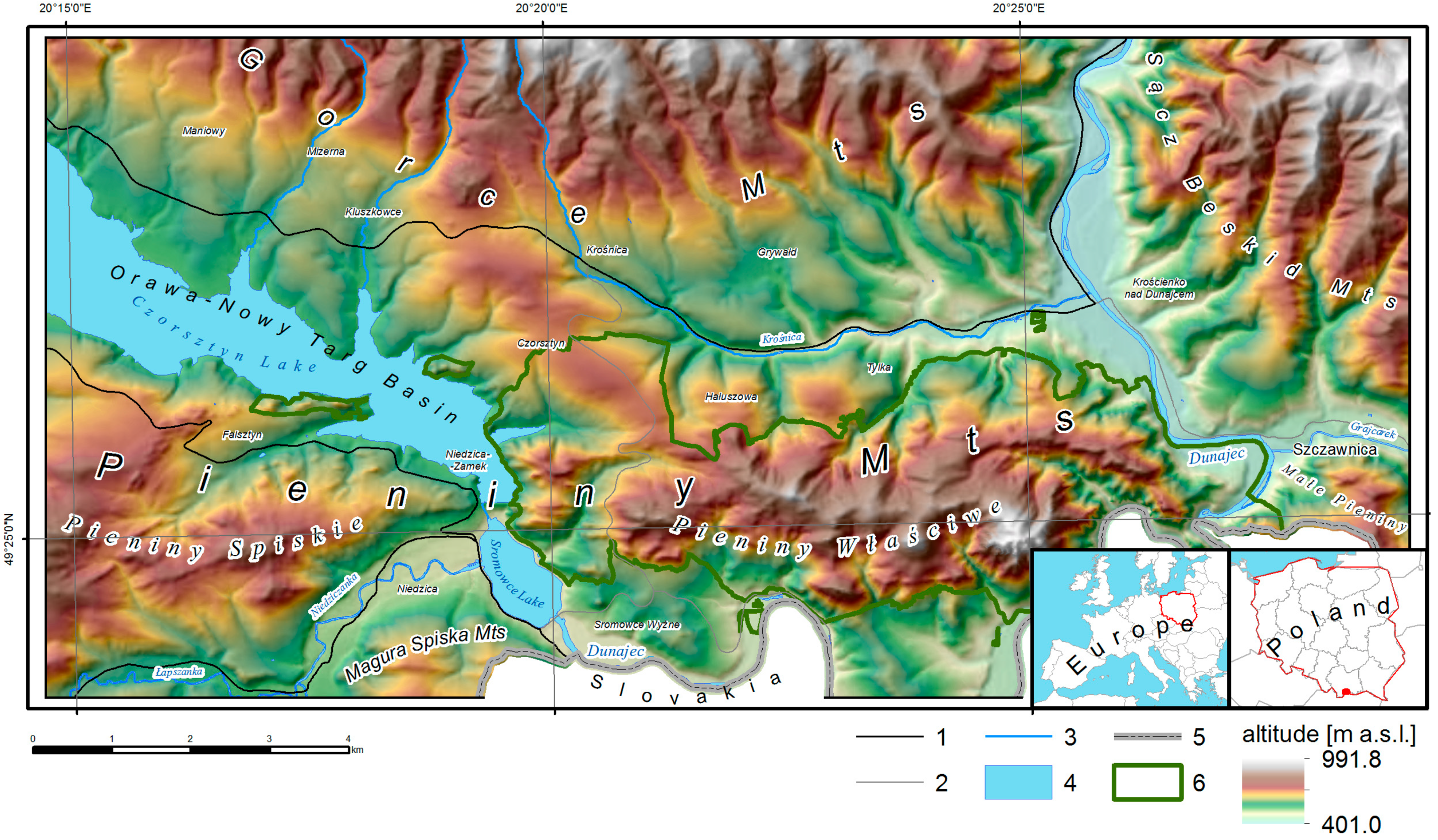
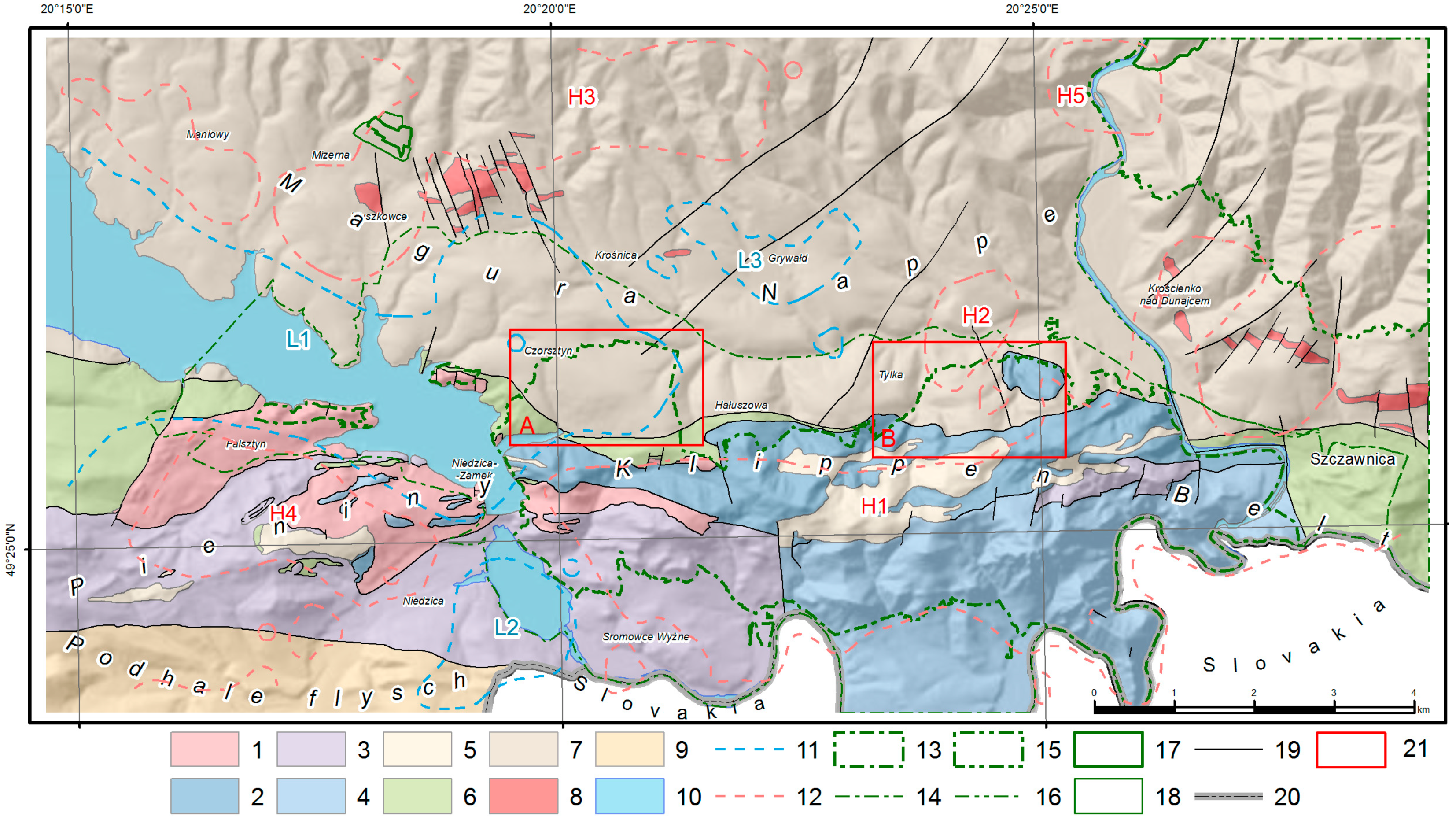
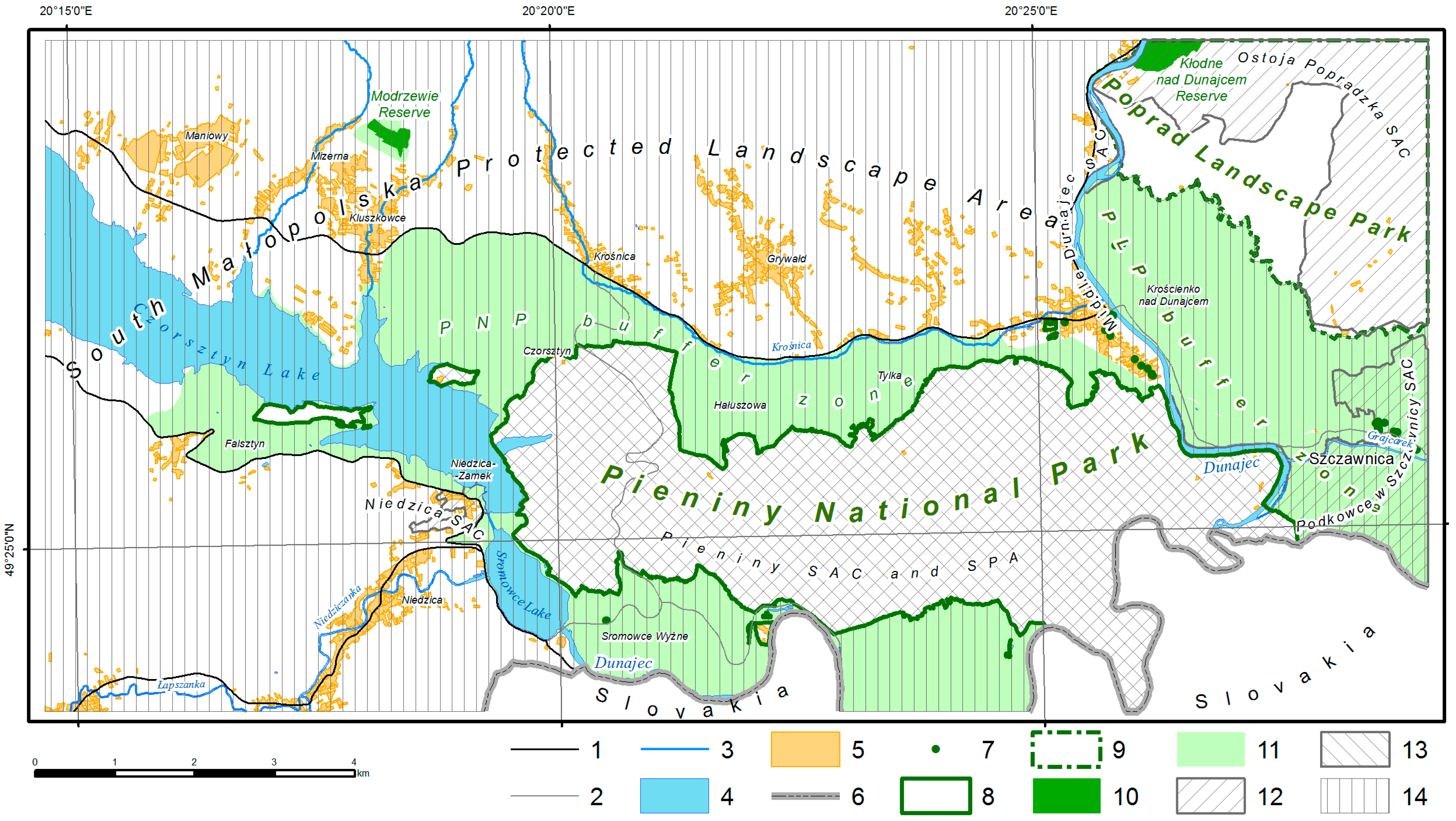
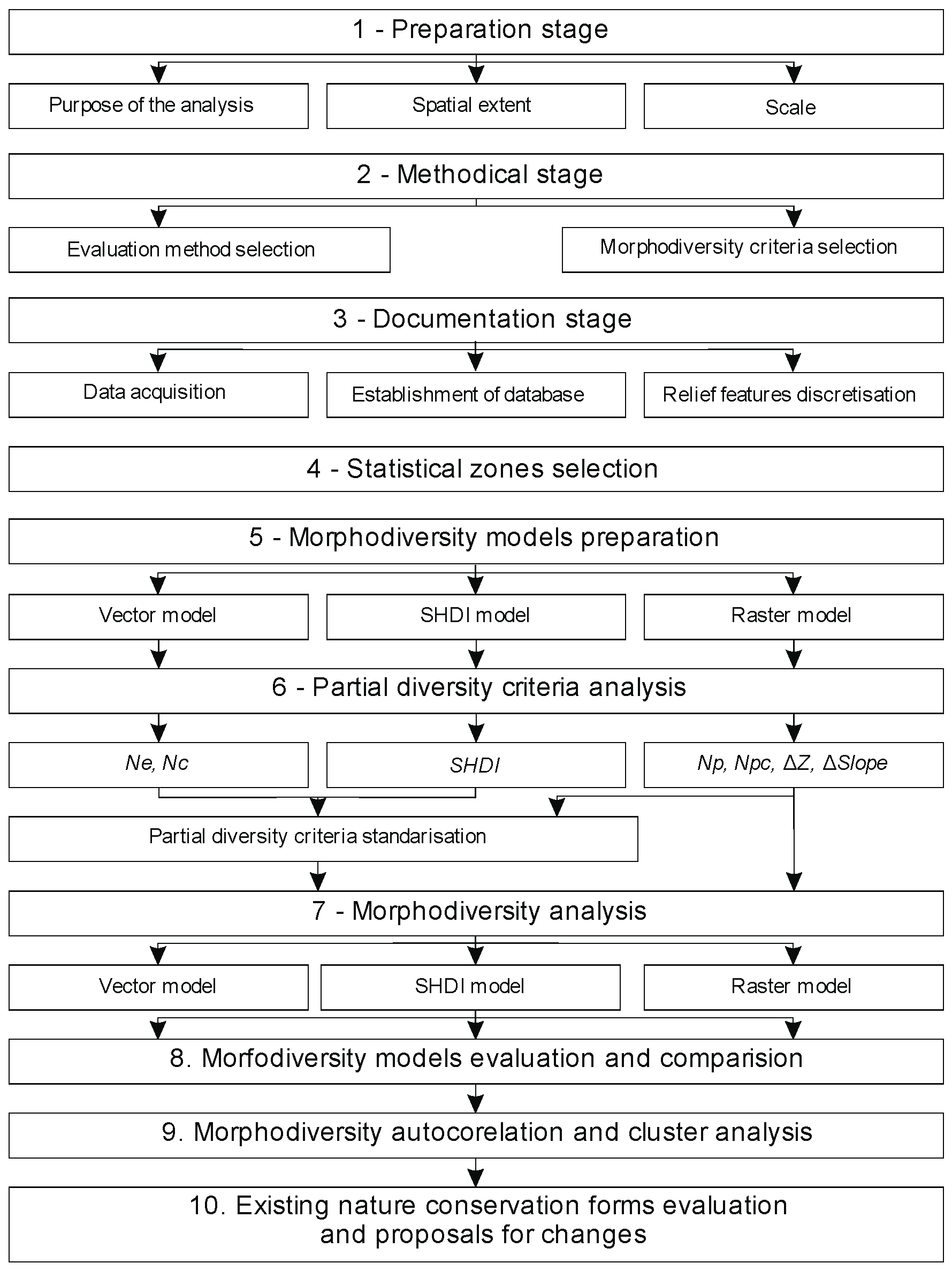
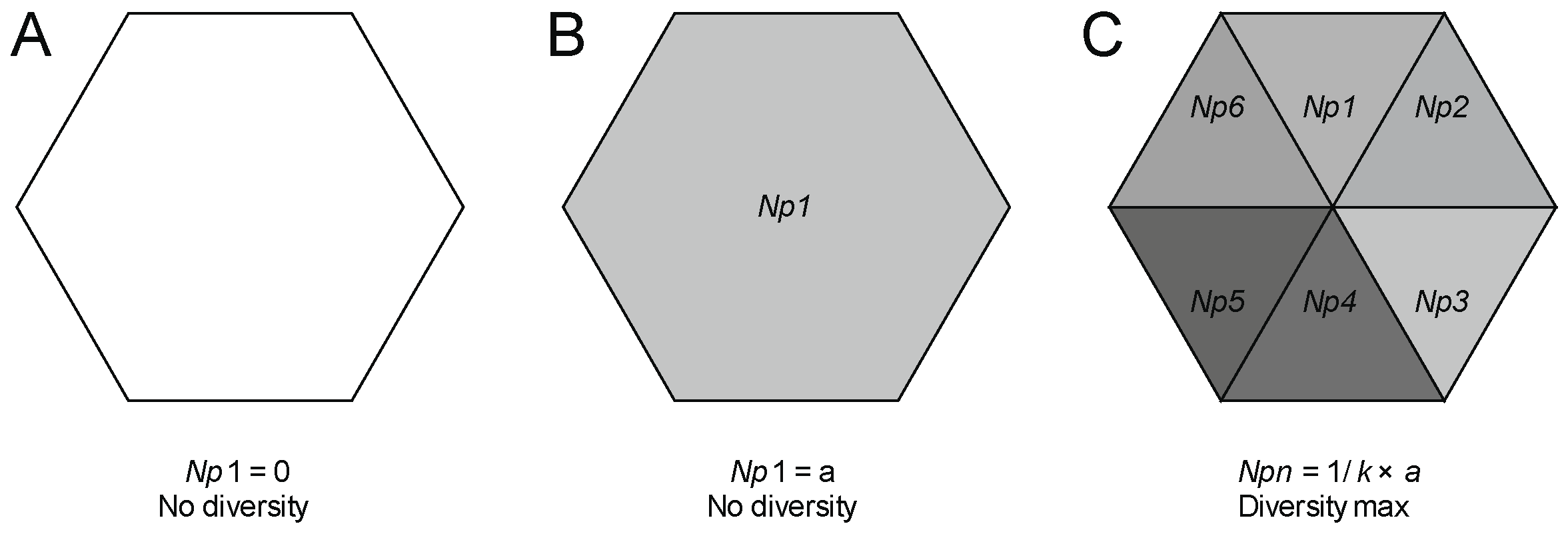
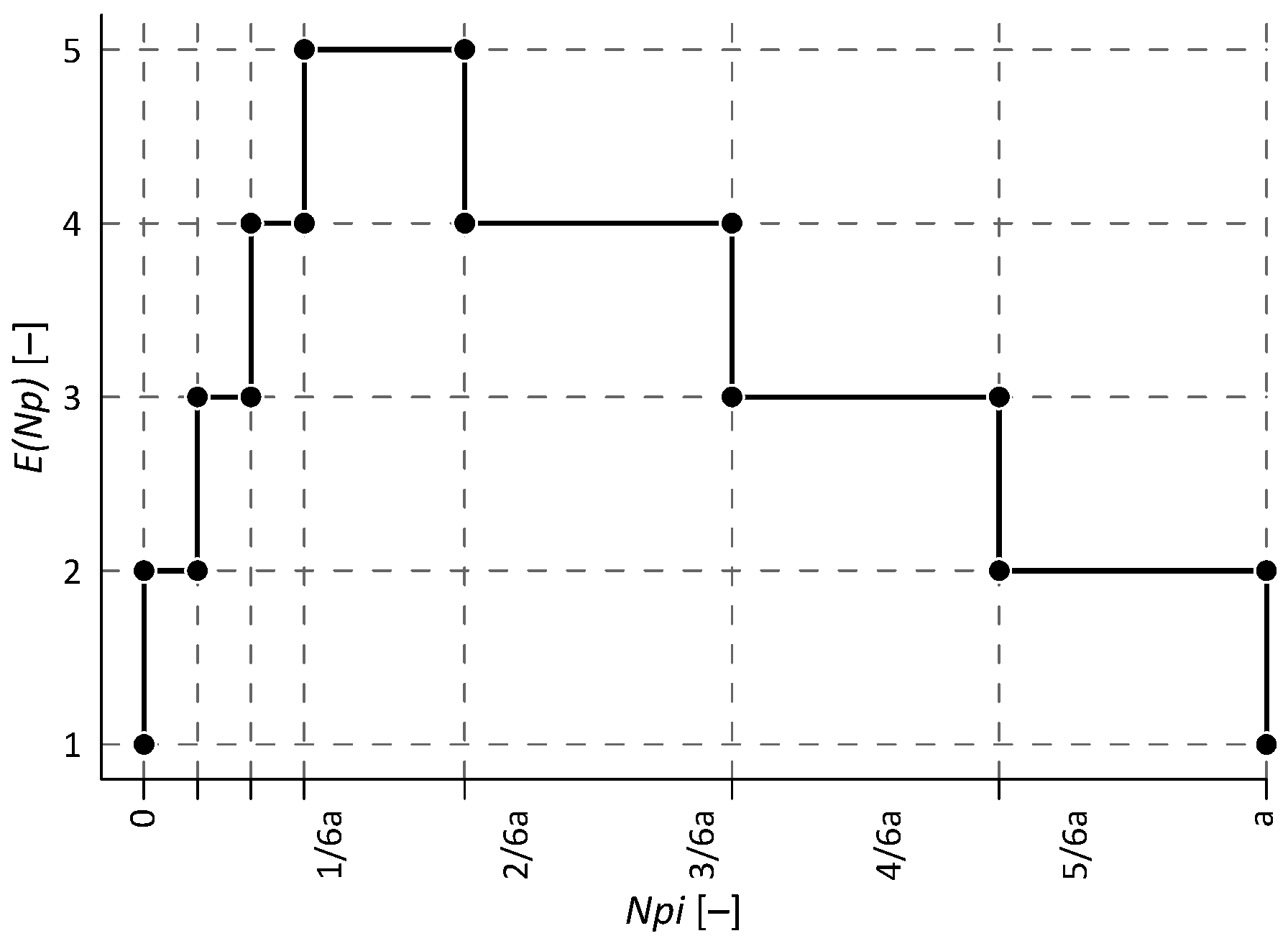
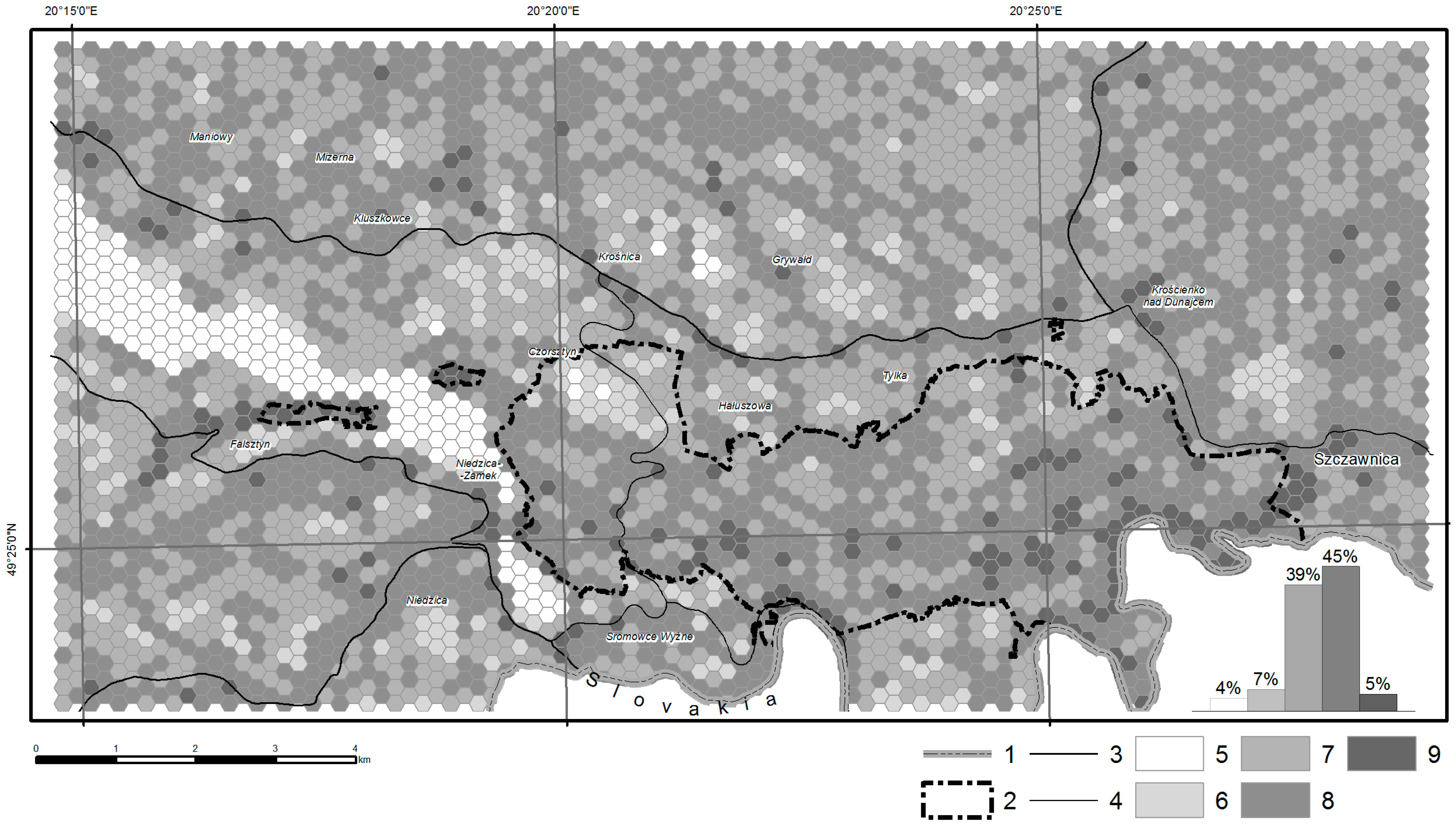
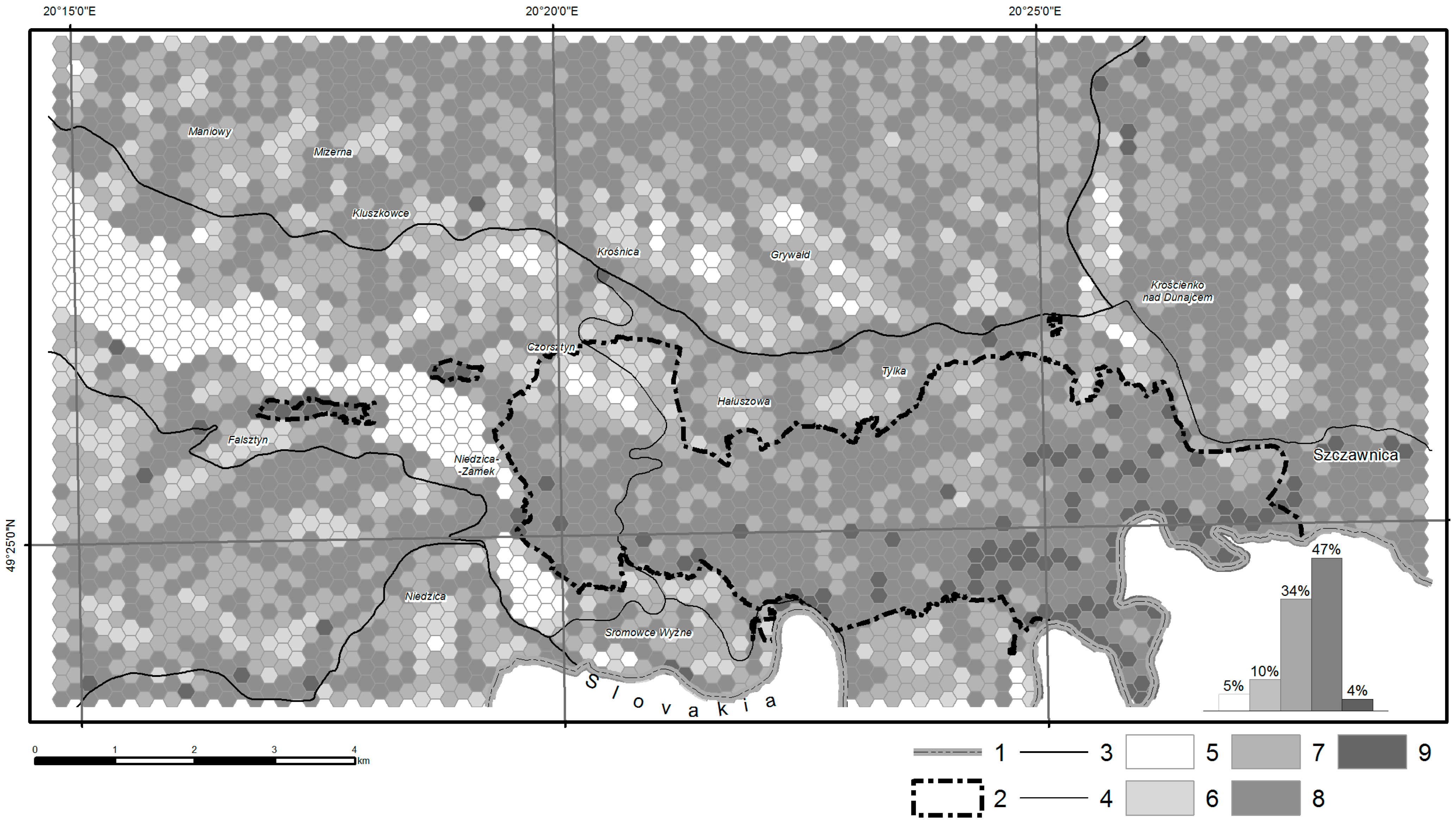
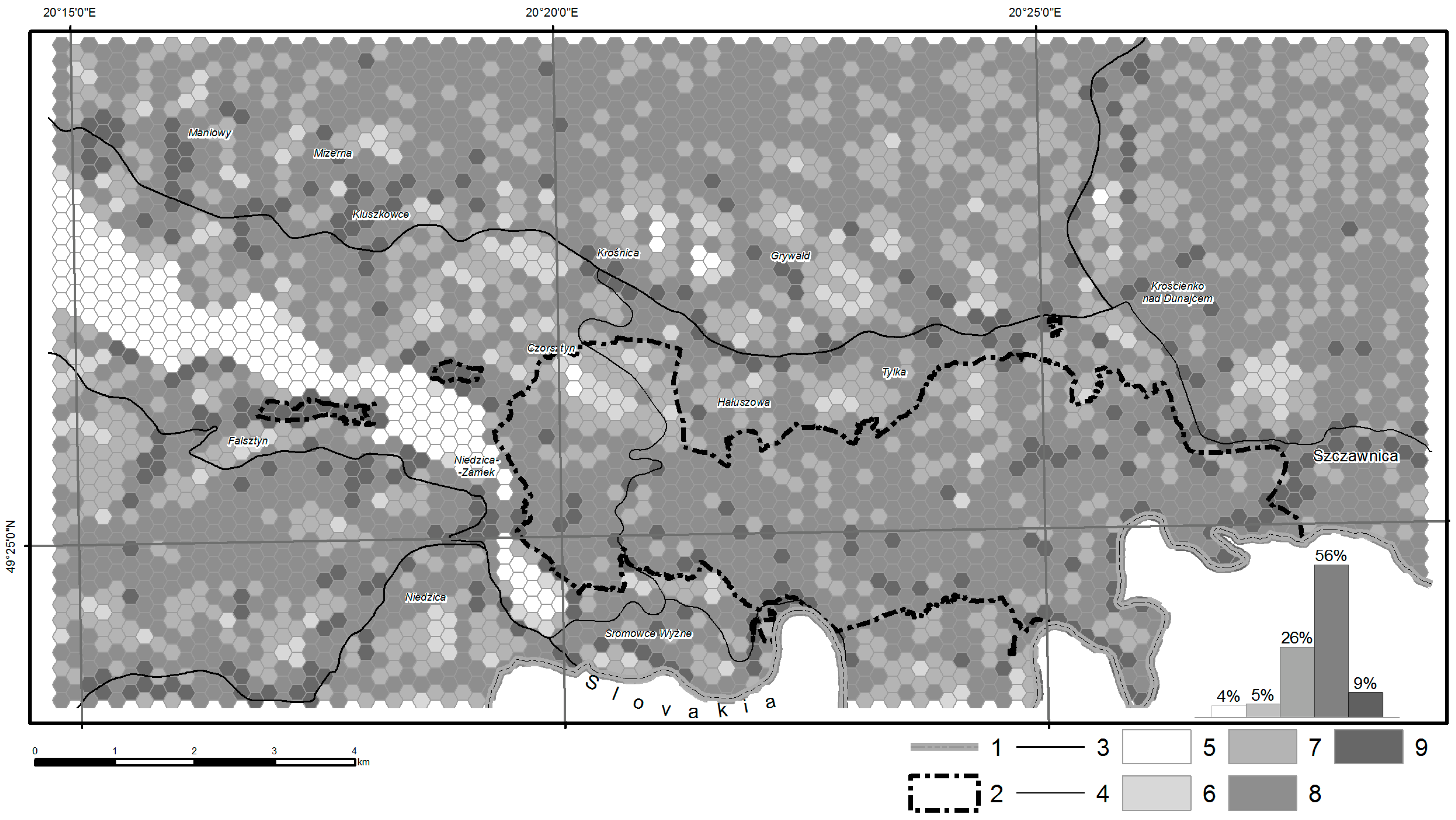
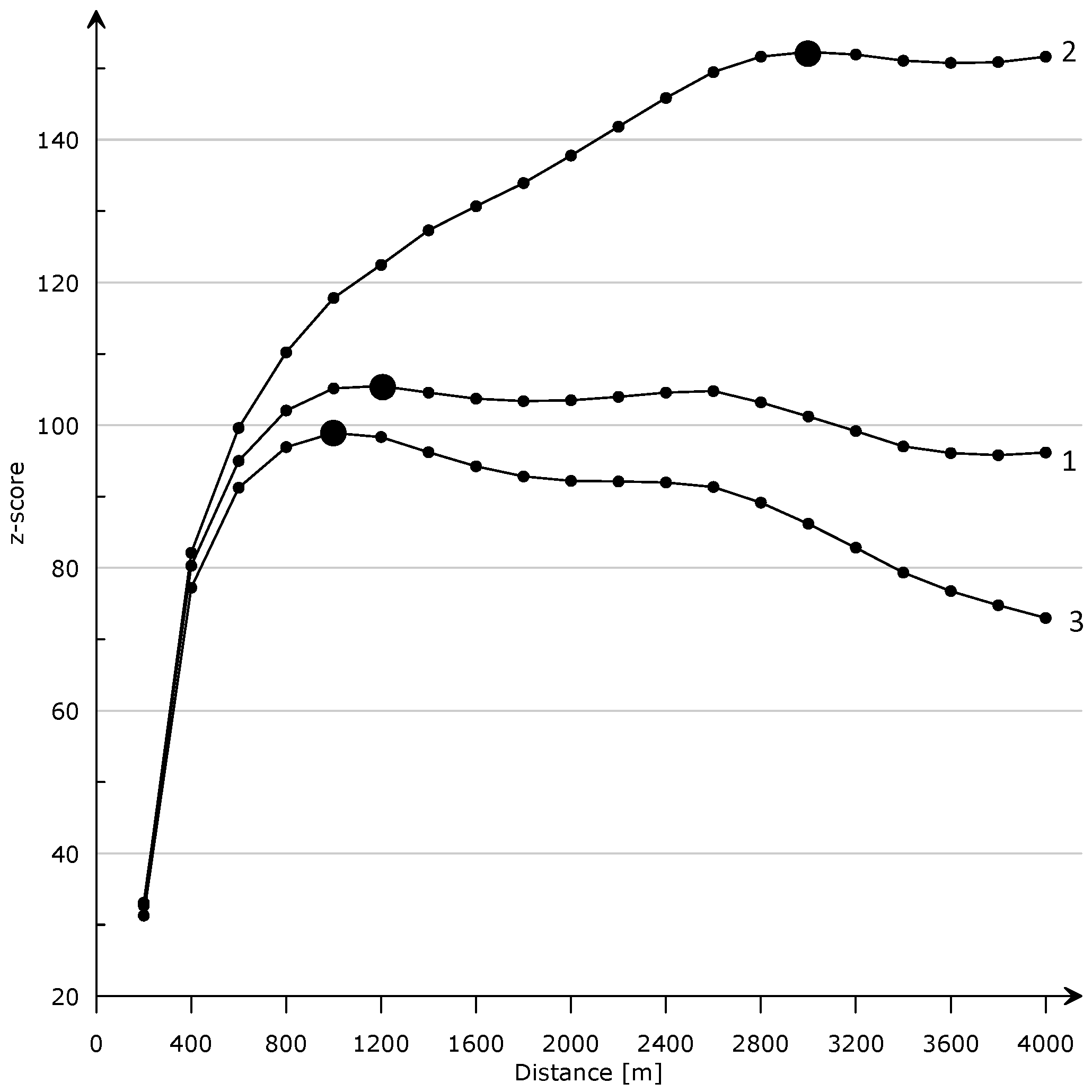
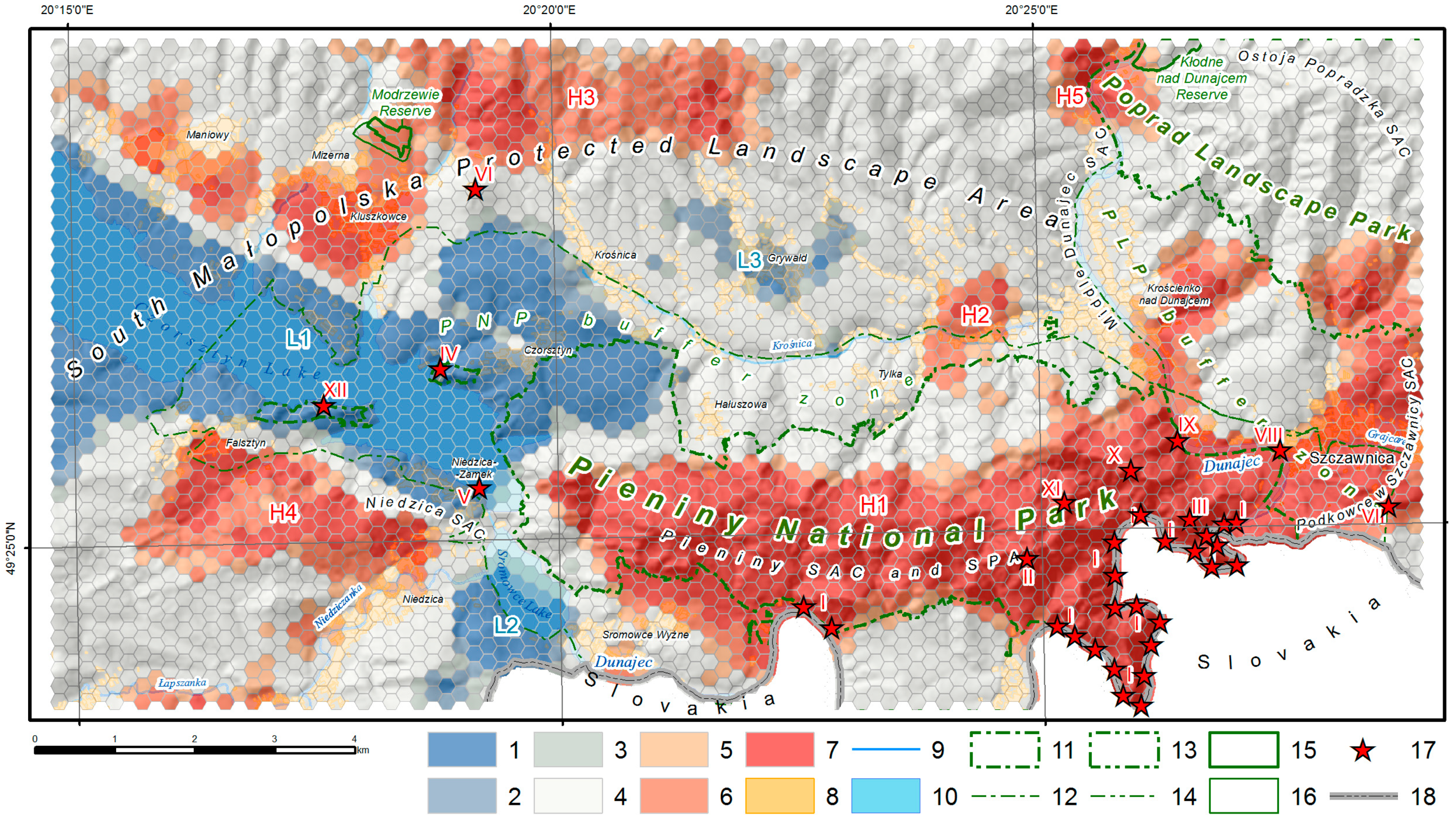
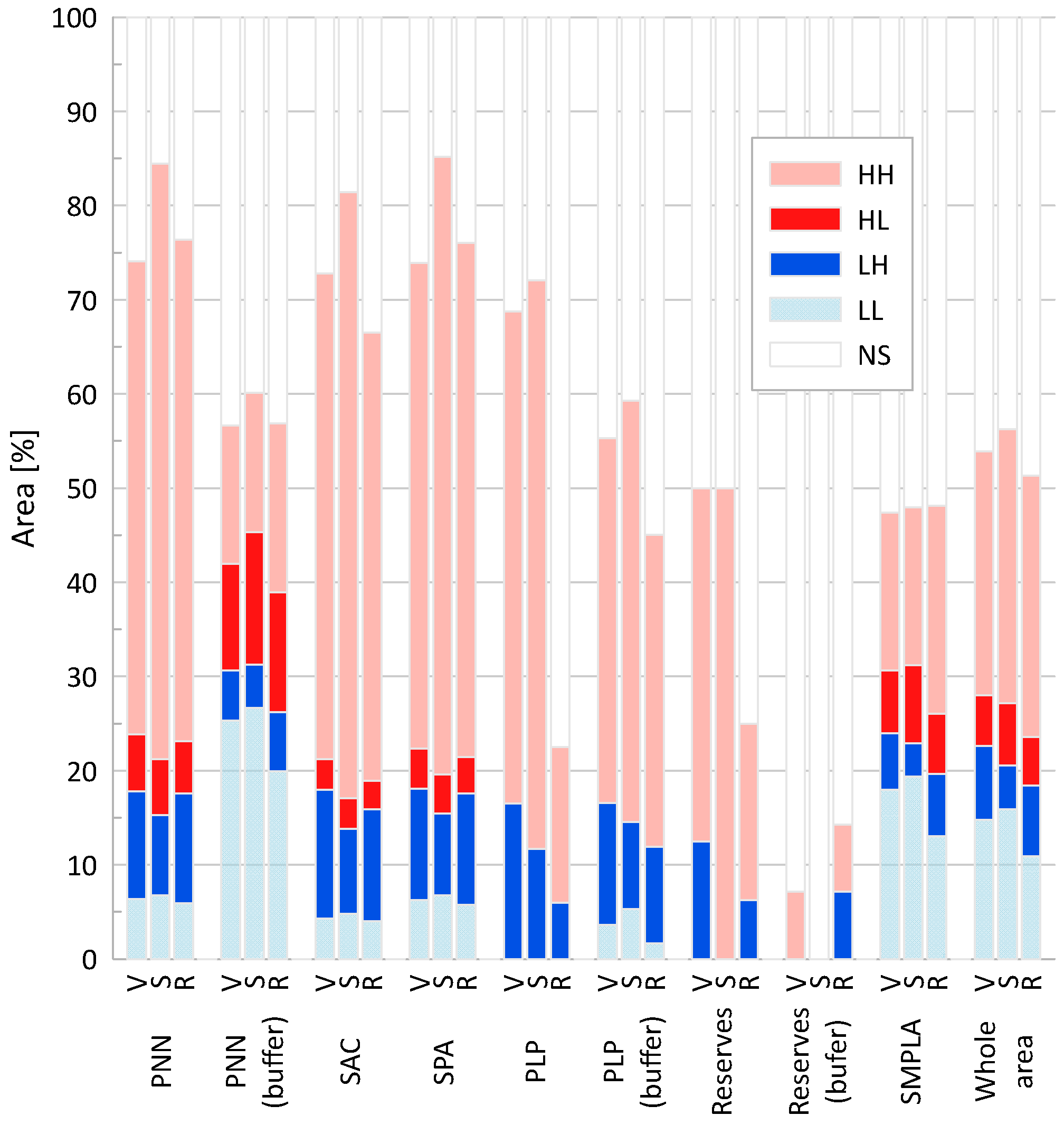
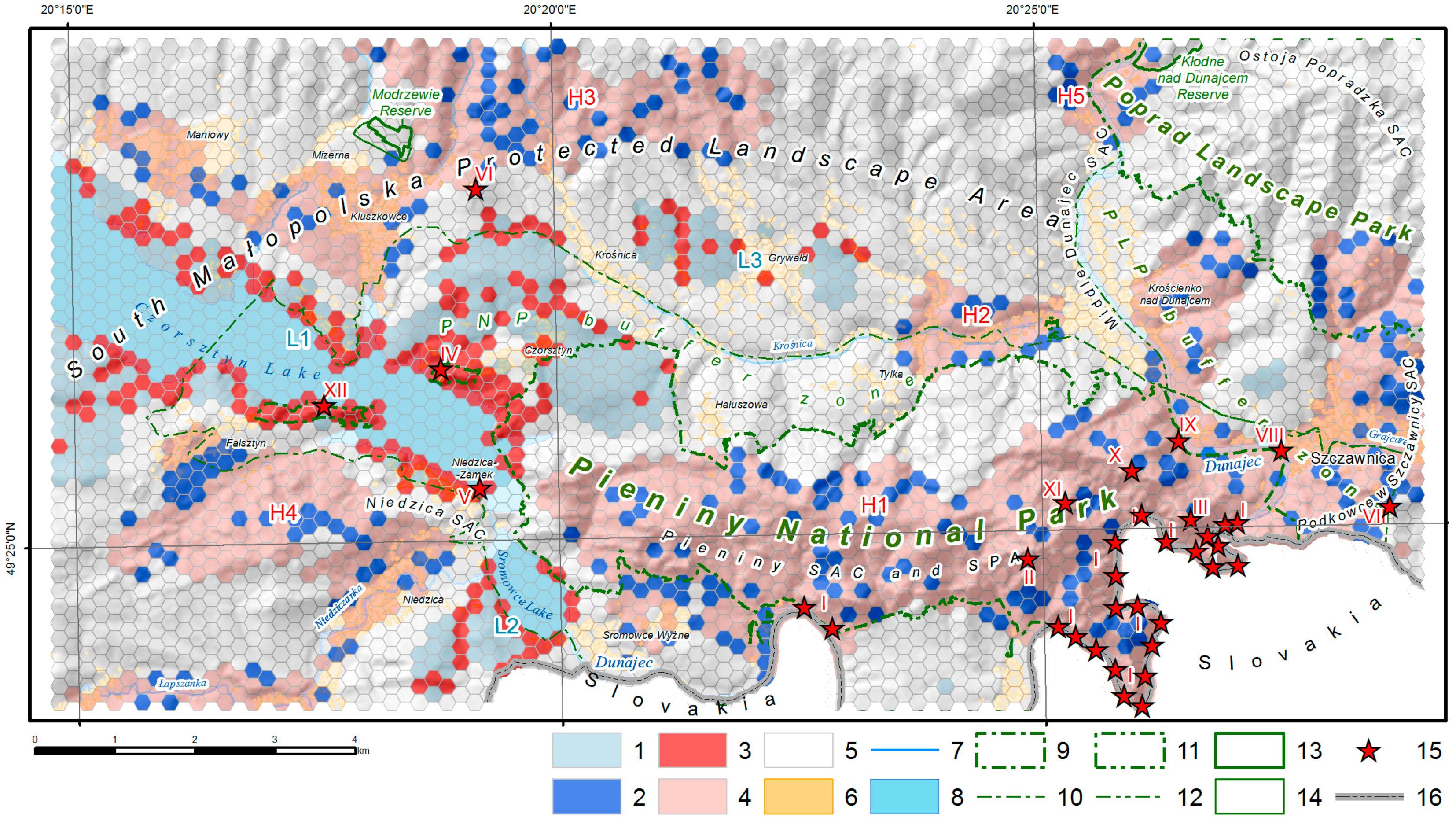
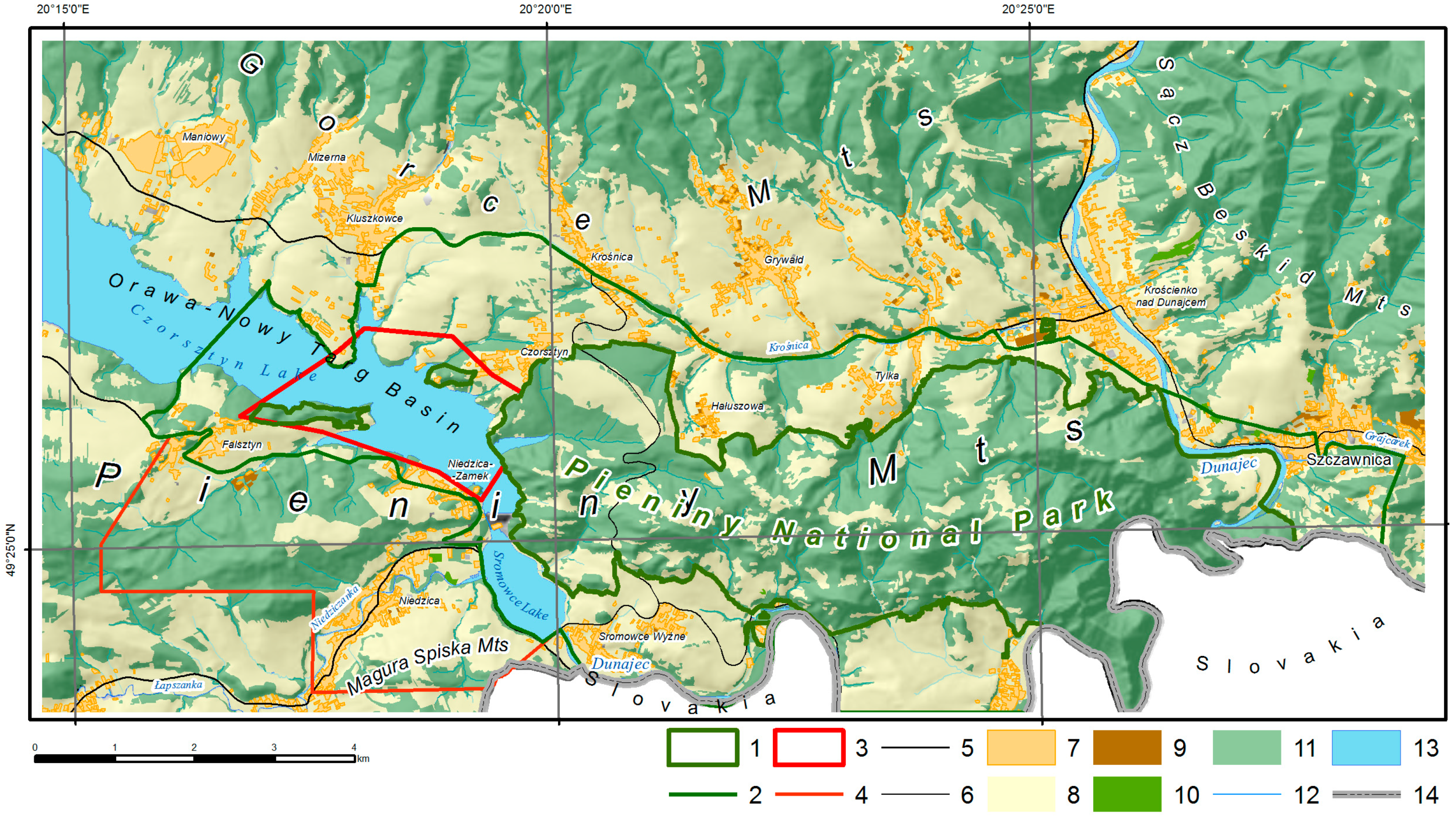
| Relief Feature | Variability | Category | Interpretation |
|---|---|---|---|
| Slope [°] | (0; 3> | 1 | |
| (3; 15> | 2 | ||
| (15; 20> | 3 | ||
| (20; 35> | 4 | ||
| (35; 90> | 5 | ||
| Aspect [°] | (0; 65>, (335; 360> | 1 | NNE |
| (65; 155> | 2 | SSE | |
| (155; 245> | 3 | SWW | |
| (245; 335> | 4 | NNW | |
| Flat | 5 | Flat | |
| Plan curvature [-] | (−217,4; −5.0>, (5.0; 212.4> | 1 | Areas with extremely steep slopes and varied plan curvature values |
| (−5.0; −0.5> | 2 | Areas with a tendency for surface runoff convergence | |
| (−0.5; 0.5> | 3 | Straight areas in plan | |
| (0.5; 5.0> | 4 | Areas with a tendency for surface runoff divergence | |
| Flat | 5 | Flat areas (including waterbodies) | |
| Profile curvature [-] | (−255.1; −5.0>, (5.0; 293.7> | 1 | Areas with extremely steep slopes and varied profile curvature values |
| (−5.0; −0.5> | 2 | Convex areas in profile | |
| (−0.5; 0.5> | 3 | Straight areas in profile | |
| (0.5; 5.0> | 4 | Concave areas in profile | |
| Flat | 5 | Flat areas (including waterbodies) | |
| SPIC [-] | TPI < −1.0 SD | 1 | Valley |
| −1.0 SD ≤ TPI < −0.5 SD | 2 | Lower slope | |
| −0.5 SD ≤ TPI ≤ 0.5 SD; Slope ≤ 5° | 3 | Flat slope | |
| −0.5 SD < TPI < 0.5 SD; Slope > 5° | 4 | Middle slope | |
| 0.5 SD < TPI ≤ 1.0 SD | 5 | Upper slope | |
| TPI > 1.0 SD | 6 | Ridge | |
| Klippen | - | 0 | Presence of klippen |
| - | 1 | No klippen |
| Relief Feature | Evaluation Criteria | Data Model | Symbol |
|---|---|---|---|
| Hypsometry | Denivelation (Zmax–Zmin) | raster | ΔZ |
| Aspect | Number of aspect elements | vector | NeAspect |
| Number of aspect categories | vector | NcAspect | |
| Aspect entropy | vector | SHDIAspect | |
| The number of pixels of 1st aspect category | raster | Np1Aspect | |
| The number of pixels of 2nd aspect category | raster | Np2Aspect | |
| The number of pixels of 3rd aspect category | raster | Np3Aspect | |
| The number of pixels of 4th aspect category | raster | Np4Aspect | |
| The number of pixels of 5th aspect category | raster | Np5Aspect | |
| The number of pixel aspect categories | raster | NpcAspect | |
| Slope | Slope range (Slopemax–Slopemin) | raster | ΔSlope |
| Number of slope elements | vector | NeSlope | |
| Number of slope categories | vector | NcSlope | |
| Slope entropy | vector | SHDISlope | |
| The number of pixels of 1st slope category | raster | Np1Slope | |
| The number of pixels of 2nd slope category | raster | Np2Slope | |
| The number of pixels of 3rd slope category | raster | Np3Slope | |
| The number of pixels of 4th slope category | raster | Np4Slope | |
| The number of pixels of 5th slope category | raster | Np5Slope | |
| The number of pixel slope categories | raster | NpcSlope | |
| Plan curvature | Number of plan curvature elements | vector | NePlanCurv |
| Number of plan curvature categories | vector | NcPlanCurv | |
| Plan curvature entropy | vector | SHDIPlanCurv | |
| Number of pixels of 1st category | raster | Np1PlanCurv | |
| Number of pixels of 2nd category | raster | Np2PlanCurv | |
| Number of pixels of 3rd category | raster | Np3PlanCurv | |
| Number of pixels of 4th category | raster | Np4PlanCurv | |
| Number of pixels of 5th category | raster | Np5PlanCurv | |
| Number of pixel categories | raster | NpcPlanCurv | |
| Profile curvature | Number of vertical curvature elements | vector | NeProfileCurv |
| Number of vertical curvature categories | vector | NcProfileCurv | |
| Profile curvature entropy | vector | SHDIProfileCurv | |
| Number of pixels of 1st category | raster | Np1ProfileCurv | |
| Number of pixels of 2nd category | raster | Np2ProfileCurv | |
| Number of pixels of 3rd category | raster | Np3ProfileCurv | |
| Number of pixels of 4th category | raster | Np4ProfileCurv | |
| Number of pixels of 5th category | raster | Np5ProfileCurv | |
| Number of pixel categories | raster | NpcProfileCurv | |
| Slope Position Index Classification (SPIC) | Number of landform elements | vector | NeSPIC |
| Number of landform categories | vector | NcSPIC | |
| Landforms entropy | vector | SHDISPIC | |
| Number of pixels of 1st category | raster | Np1SPIC | |
| Number of pixels of 2nd category | raster | Np2SPIC | |
| Number of pixels of 3rd category | raster | Np3SPIC | |
| Number of pixels of 4th category | raster | Np4SPIC | |
| Number of pixels of 5th category | raster | Np5SPIC | |
| Number of pixels of 6th category | raster | Np6SPIC | |
| Number of pixel categories | raster | NpcSPIC | |
| Klippen | Number of klippen | vector | NeKlippen |
| Presence of klippen | vector | NcKlippen | |
| Klippen entropy | vector | SHDIKlippen | |
| Number of pixels | raster | Np1Klippen | |
| Presence of pixels with klippen | raster | NpcKlippen |
| Morphodiversity Model | Equation of the Model | |
|---|---|---|
| Vector | MDvec = St(ΔZ) + St(NeAspect) + St(NcAspect) + St(ΔSlope) + St(NeSlope) + St(NcSlope) + St(NePlanCurv) + St(NcPlanCurv) + St(NeProfileCurv) + St(NcProfileCurv) + St(NeSPIC) + St(NcSPIC) + St(NeKlippes) + St(NcKlippes) | (2) |
| Entrophy | MDSHDI = St(ΔZ) + St(SHDIAspect) + St(ΔSlope) + St(SHDISlope) + St(SHDIPlanCurv) + St(SHDIProfileCurv) + St(SHDISPIC) + St(SHDIKlippes) | (3) |
| Raster | MDRas = E(ΔZ) + E(Np1Aspect) + E(Np2Aspect) + E(Np3Aspect) + E(Np4Aspect) + E(Np5Aspect) + E(NpcAspect) + E(ΔSlope) + E(Np1Slope) + E(Np2Slope) + E(Np3Slope) + E(Np4Slope) + E(Np5Slope) + E(NpcSlope) + E(Np1PlanCurv) + E(Np2PlanCurv) + E(Np3PlanCurv) + E(Np4PlanCurv) + E(Np5PlanCurv) + E(NpcPlanCurv) + E(Np1ProfileCurv) + E(Np2ProfileCurv) + E(Np3ProfileCurv) + E(Np4ProfileCurv) + E(Np5ProfileCurv) + E(NpcProfileCurv) + E(Np1SPIC) + E(Np2SPIC) + E(Np3SPIC) + E(Np4SPIC) + E(Np5SPIC) + E(Np6SPIC) + E(NpcSPIC) + E(NpKlippes) + E(NpcKlippes) | (4) |
| Spearman’s Rank Correlation Coefficient [-] | ||||
|---|---|---|---|---|
| Model | Vector | SHDI | Raster | |
| Evaluations coincidence [%] | Vector | - | 0.73 | 0.75 |
| SHDI | 69.6 | - | 0.77 | |
| Raster | 69.8 | 66.9 | - | |
Disclaimer/Publisher’s Note: The statements, opinions and data contained in all publications are solely those of the individual author(s) and contributor(s) and not of MDPI and/or the editor(s). MDPI and/or the editor(s) disclaim responsibility for any injury to people or property resulting from any ideas, methods, instructions or products referred to in the content. |
© 2023 by the authors. Licensee MDPI, Basel, Switzerland. This article is an open access article distributed under the terms and conditions of the Creative Commons Attribution (CC BY) license (https://creativecommons.org/licenses/by/4.0/).
Share and Cite
Bartuś, T.; Mastej, W. Morphodiversity as a Tool in Geoconservation: A Case Study in a Mountain Area (Pieniny Mts, Poland). Sustainability 2023, 15, 11357. https://doi.org/10.3390/su151411357
Bartuś T, Mastej W. Morphodiversity as a Tool in Geoconservation: A Case Study in a Mountain Area (Pieniny Mts, Poland). Sustainability. 2023; 15(14):11357. https://doi.org/10.3390/su151411357
Chicago/Turabian StyleBartuś, Tomasz, and Wojciech Mastej. 2023. "Morphodiversity as a Tool in Geoconservation: A Case Study in a Mountain Area (Pieniny Mts, Poland)" Sustainability 15, no. 14: 11357. https://doi.org/10.3390/su151411357
APA StyleBartuś, T., & Mastej, W. (2023). Morphodiversity as a Tool in Geoconservation: A Case Study in a Mountain Area (Pieniny Mts, Poland). Sustainability, 15(14), 11357. https://doi.org/10.3390/su151411357






